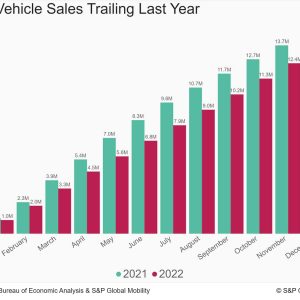
S&P Global Mobility: November auto sales continue previous three-month trend
Ongoing economic headwinds suggest no news could be good news
concerning car demand levelsWith volume for the month projected at 1.122 million units,
November U.S. vehicle sales are estimated to translate to an approximated
sales speed of 14.1 million units (seasonally adjusted yearly rate:
SAAR). This would represent a sustained improvement from the May
through September duration but will show a decrease from Octobers.
14.9 million-unit rate, according to S&P Global Mobility.
analysis.The day-to-day selling rate metric in November (around 44-45K.
per day) would be in-line with levels considering that September. Translation:.
From a non-seasonally adjusted volume viewpoint, vehicle sales.
continue to plug along at a consistent rate.” Sales must continue to enhance, given the anticipated sustained,.
however moderate, development in general production and stock levels,”.
stated Chris Hopson, primary expert at S&P Global Mobility.
” However, we also continue to monitor for signals of.
faster-than-expected development in inventory. Currently, there are no.
clear indications; stocks have advanced as prepared for. But any.
sign of faster than predicted growth in the total stock of.
brand-new cars might imply that vehicle customers are feeling the.
pressure of the existing economic headwinds and pulling back from the.
market.” As an outcome, Octobers SAAR increase is likely to be an abnormality.
compared to the remainder of the year, Hopson said, including that.
there are expectations of volatility in the month-to-month results.
beginning in early 2023. Market share of battery-electric cars is expected to reach.
5.9% in November. Outside of the large coastal cities,.
retail registrations of EVs have yet to take hold, according to.
analysis from S&P Global Mobility.The top-eight EV markets in the United States are all in seaside states and.
represent 50.5% of total EV registrations up until now in 2022 (through.
August). The greater Los Angeles and San Francisco urban.
locations alone account for almost one-third of overall share of the United States.
EV market. On the other hand the Heartland states market share of EV sales.
is hardly half of what they add to total vehicle.
registrations.” BEV market share control on the 2 coasts is credited to.
their greater mix of early adopters compared to purchasers in middle.
America,” said Tom Libby, associate director of Loyalty Solutions.
and Industry Analysis at S&P Global Mobility. “Their.
demographic profile is more in sync with the standard BEV purchaser.
than the middle-American profile.” But Libby sees potential for EV approval in top heartland.
markets: “More acceptance and much more comprehensive customer awareness is.
resulting in a natural development of adoption from the coasts to.
the Heartland.” (For more on this analysis of EVs in the Heartland,.
please see.
this unique report.) Supporting the EV advancement, item reveals surrounding the.
Los Angeles Auto Show last week continue to show the OEM.
focus.According to Stephanie Brinley, associate director of.
AutoIntelligence at S&P Global Mobility, “As automobile programs at.
their finest highlight what people will be driving in coming years,.
the reveals throughout the Los Angeles Auto Show reflect the continuing.
push towards electric and amazed lorries.” Of note, Fiat revealed it will bring a version of the European.
500 EV to the U.S. beginning in early 2024, restoring the 500e.
nameplate. Toyotas reveal of the 2023 Prius hybrid consisted of a.
Prime cut that will double the hatchbacks EV-only variety, while.
the automaker also revealed a making of the bZ (” Beyond Zero”).
electric-vehicle principle, previewing an upcoming compact SUV.
Vietnamese entrant VinFast showed U.S.-trim variations of.
two EV crossover additions to its lineup – bringing its capacity.
US offerings to 4.
This post was released by S&P Global Mobility and not by S&P Global Ratings, which is an independently handled division of S&P Global.
Leave a reply